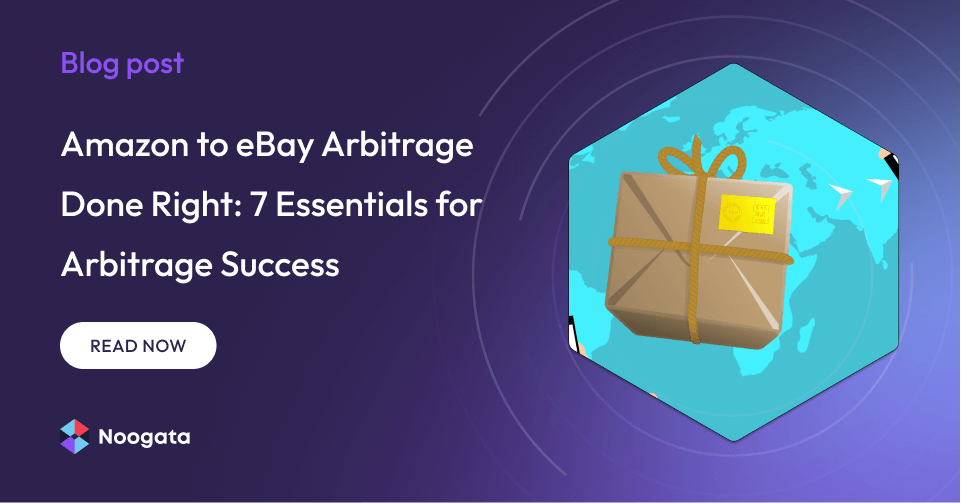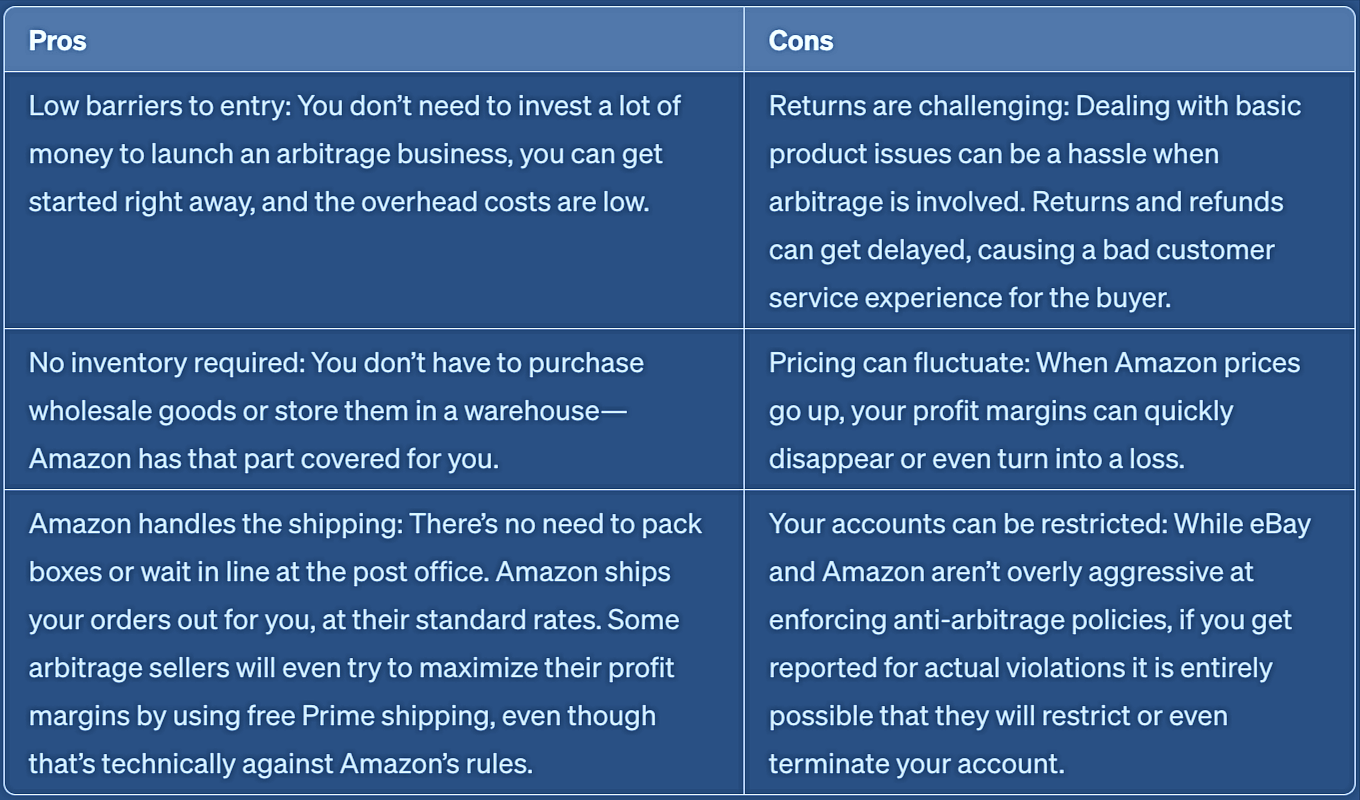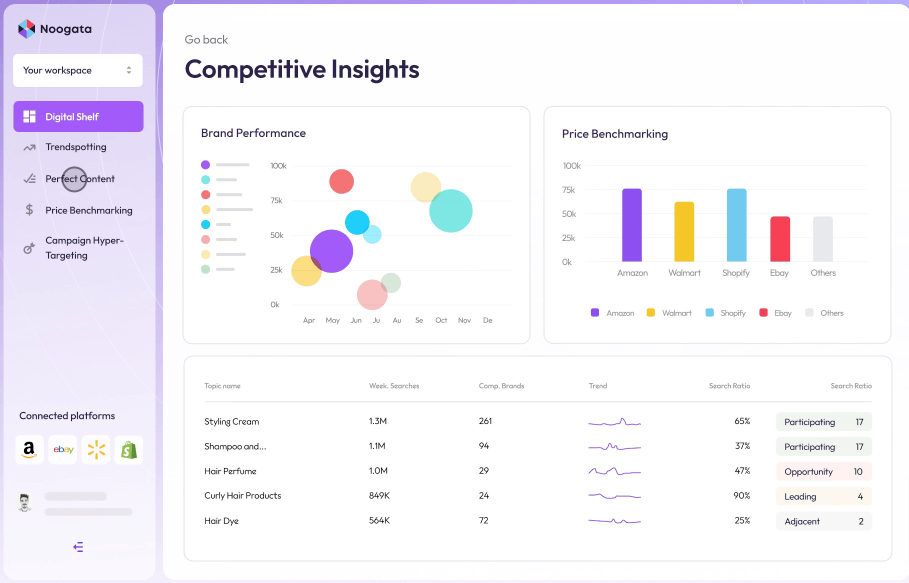Picture this: you’re on eBay, shopping for unique products. You find something you like and order it. The product arrives at your door a few days later—but it’s in one of those unmistakable Amazon packing envelopes. What’s going on here? A glitch in the matrix? A massive corporate merger that somehow nobody is talking about? Nope—it’s just Amazon to eBay arbitrage in action.
In eCommerce, arbitrage is a popular (but somewhat controversial) business model that lets you sell to customers on one retail marketplace by sourcing their orders on a second, cheaper retail marketplace. With more than 135 million active users, many of them older consumers who prefer it to newer platforms, eBay is one of the easiest places to launch an arbitrage seller account—and Amazon’s low prices and shipping costs make it an excellent source for products.
Arbitrage lets sellers earn revenue without buying products from wholesalers and maintaining an on-hand inventory, but this model has some risks and downsides. This post will explain the essential steps for succeeding at Amazon to eBay arbitrage.
What exactly is Amazon to eBay arbitrage?
Amazon to eBay arbitrage works by selling products on eBay that can be purchased on Amazon for a lower price. The seller keeps the difference in price as their profit, minus any fees each platform might charge.
When an eBay customer buys a product from an arbitrage seller, the seller immediately goes on Amazon, orders the product, and has it shipped to the customer as a gift. This protects the seller’s personal information and hides the price from the customer, but there’s no getting around the fact that the package will arrive in Amazon packaging.
This type of arbitrage is similar to dropshipping, but there are some key differences. Dropshipping is based on an agreed relationship between the seller and their supplier. However, eBay to Amazon arbitrage is carried out without Amazon’s knowledge or agreement.
Is Amazon to eBay Arbitrage legal?
Fulfilling eBay orders by “gifting” people products from Amazon isn’t against the law, but it can violate eBay and Amazon policies. While Amazon is more lenient about the practice, eBay has enacted policies prohibiting arbitrage in most markets, including the UK, the US, and Australia.
The penalties for violating eBay’s policy include account suspension, removal of listings, loss of special account privileges, and lower search rankings. However, many arbitrage sellers continue to operate on eBay, which suggests that policy enforcement is not always consistent.
Although Amazon does not prohibit arbitrage, it does forbid Prime customers to use their free shipping benefits to ship resale orders. Sellers should also be careful to ensure they’re following any local regulations related to protecting consumer rights, personal data, and intellectual property.
Pros and Cons of Amazon to eBay Arbitrage
Is Amazon to eBay Arbitrage a worthwhile business model? It depends on who you ask.
Consumers sometimes get upset when they realize they’ve purchased an item through arbitrage and could have gotten it cheaper elsewhere. Amazon sellers may believe that their reputation is being damaged by unauthorized resellers exploiting their work to develop and market their products.
Successful arbitrage sellers, on the other hand, may feel like they’ve found a low-risk, low-overhead retail enterprise that brings in a substantial revenue stream.
Whichever side you fall on, the arbitrage model has some clear pros and cons. Let’s break them down:
If you’re going ahead with an eBay to Amazon arbitrage business, the best way to mitigate the downsides is to follow the essential steps for success.
7 Essentials for Arbitrage Success
1. Research the Market
Only some products are ideal choices for arbitrage. The highest profits tend to come from selling goods priced in the midrange, avoiding the extremes of very low-priced or high-ticket items. Some products, like food, are best avoided entirely. Keyword research is particularly important for showing you what consumers are hoping to find.
Competition can be fierce on eCommerce platforms like eBay, and it pays to find a market niche that isn’t oversaturated with other arbitrage sellers. A tool like Noogata can speed up your efforts by providing accurate, real-time insights into your target market.
2. Price Your Products Strategically
Arbitrage is more likely to bring in good money when you price your items high enough to cover your seller fees and leave you with a decent profit, but not so high that customers start looking for a better deal. A markup between 5% and 15% is an average baseline, but researching completed competitor sales can give you a clearer picture of how high you can go.
3. Use the Right Software Tools
Many software tools are designed to make life easier for arbitrage sellers. Programs like Easync, PriceYak, and SaleFreaks can help you source viable Amazon products to resell, create listings, blacklist protected items, monitor activity on both platforms, and more. You can also use AI Amazon growth solutions like Noogata to identify purchasing trends and track other sellers’ activities.
4. Automate Your Process
Arbitrage is a numbers game, and the higher you can scale up your listing volume, the more revenue you will bring in. Manually listing thousands of items for sale would take forever, so use your arbitrage software solutions to automate creating listings and placing the corresponding Amazon orders.
5. Use High Quality Photos and Product Descriptions
Use high-quality original photos and product descriptions in your listings as much as possible. They will make your listings more appealing to customers and help you stand out from your competitors. Plus, when you refrain from copying content directly from Amazon, you don’t have to worry about angry Amazon sellers targeting you with copyright violation complaints.
6. Keep a Close Eye on Pricing Changes and Product Availability
Something else your software solutions can help you with is monitoring Amazon for price increases and out-of-stock items. Either of these situations can throw a serious wrench in the works when customers purchase from you, so configure your software to automatically adjust prices to preserve your profit margins and delist items that are no longer available on Amazon.
7. Provide Excellent Customer Service
Returns, refunds, and other common customer service issues can be hard to manage as an arbitrage seller, so make sure you go the extra mile to promptly resolve any problems your customers are having. Respond to emails immediately, and don’t delay sending out refunds while you deal with Amazon on your end. A bad experience can easily lead to negative eBay feedback that hurts your reputation, so do whatever it takes to make the customer happy and earn a positive review instead.
Every Arbitrage Seller Needs Competitive Intelligence
A well-run eBay to Amazon arbitrage store can be a great way to make Amazon marketplace products available to consumers who prefer to shop on eBay—while making a tidy profit for yourself.
AI-enhanced insights into consumer trends, market conditions, and competitor activity will keep you growing in a competitive, high-volume business like eBay to Amazon arbitrage. Noogata can be an ideal competitive intelligence and Amazon monitoring solution for arbitrage sellers who want to maximize their opportunities.
Try out a demo today to see what Noogata can do to boost your eBay to Amazon arbitrage business.






